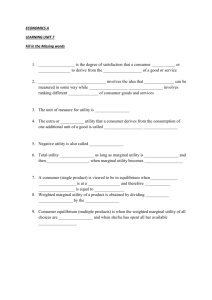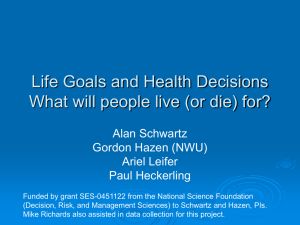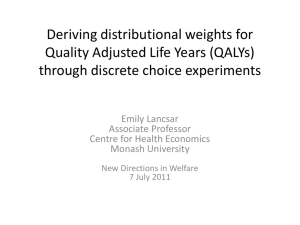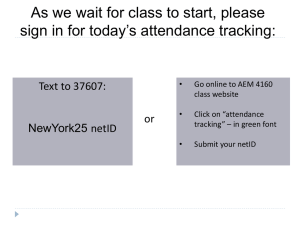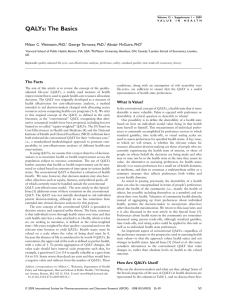Benefit-Cost Analysis
advertisement
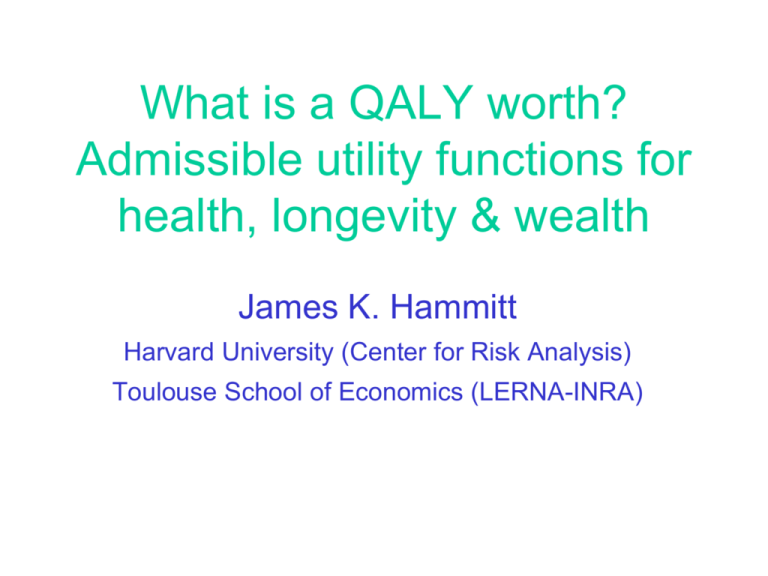
What is a QALY worth? Admissible utility functions for health, longevity & wealth James K. Hammitt Harvard University (Center for Risk Analysis) Toulouse School of Economics (LERNA-INRA) Standard metrics for valuing health Willingness to pay (WTP) • Widely used in environmental & transportation applications Quality-adjusted life years (QALYs) • Widely used in public health and medical applications • DALYs (disability-adjusted) Utility for health and wealth • What utility functions are consistent with both concepts? • Implications for WTP to reduce health risk 2 Louis’ contribution U(w, h) U1 > 0, U2 > 0 U11 < 0, U22 < 0 U12 ≥ 0 Bleichrodt, Crainich, Eeckhoudt, ‘Comorbidities and the willingness to pay for health improvements’, J Public Econ 2003 3 Quality-adjusted life years Sum of duration-weighted “health-related quality of life” • q(h) = HRQL QALYs v q (h) • T = duration • v(∙) usually linear or present value T Neglect non-health consequences • What is ‘health’ (h)? • Includes ‘self-care’ & ‘usual activities’? 4 QALYs Strong assumptions about preferences 1. Constant proportional tradeoff of duration for health • HRQL independent of duration, consumption, & other factors 2. Risk preference for duration independent of health • Can be generalized 5 Willingness to pay Compensating variation • Change in money (that can be used for any purpose) that exactly offsets change in health risk Weak assumptions • More money is better – Non-satiation (local) 6 Admissible utility functions Assume (for any level of wealth) • Preferences for health and longevity are consistent with QALYs – Q(h, T) = v[q(h), T] – q(h) independent of w Then (future) lifetime utility u(h, T, w) = [Q(h, T)] a(w) + b(w) – a(w) > 0 7 Marginal utility of wealth u(h, T, w) = [Q(h, T)] a(w) + b(w) U Qa w b w w b' ≥ 0 (standard, marginal utility of bequest) a' > 0 ↔ marginal utility of wealth greater if alive than dead (standard) → marginal utility of wealth increasing with Health (standard?) Longevity (highly plausible) → 𝑢12 = 𝜕2 𝑢 𝜕𝑤𝜕ℎ >0 8 Marginal WTP per QALY (m) u(h, T, w) = [Q(h , T)] a(w) + b(w) a w dw w m dQ Qa w b w Q Marginal value of QALY Effect of health & longevity on wealth (neglect) m is independent of Q (future health & longevity) iff a' = 0 → marginal utility of wealth independent of survival, health, & longevity a' > 0 → m decreases with Q Diminishing marginal WTP with severity & duration of potential illness WTP increases with age and chronic/future illness 9 Value per statistical life ua w ud w u VSL 1 p ua w pua w Eu ua = utility if survive period ud = utility if die (bequest) ua > ud u a' > u d' ≥ 0 Drèze, ‘L’utilité sociale d’une vie humaine’, Revue Française de Recherche Opérationnelle 1962 10 QALYs and VSL ua w Qa w bw ud w bw Utility if survive Utility of bequest Qa w VSL 1 p Qaw bw b'(w) = 0 → VSL is independent of QALYs b'(w) > 0 → VSL increases with QALYs, but less than proportionately 11 Implications WTP per QALY not constant • Decreases with future QALYs • Value of reducing morbidity risk not proportional to expected QALY gain VSL not proportional to future QALYs • Decreases with future QALYs – VSL independent of QALYs if indifferent to bequest (b' = 0) • Value of reducing mortality risk not proportional to expected QALY (or life expectancy) gain 12





